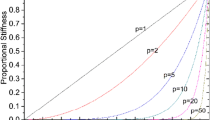Abstract
Aiming at improving the optimization efficiency, a theoretical optimization method for drawbead is proposed based on plastic flow principles. Essentially different from the existing common optimization methods which are on the basis of mathematics or statistics, this method, which can accurately reflect the relationship between the forming quality and the drawbead restraining force from the perspective of plastic flow theory, is a professional optimization method with higher efficiency. Plastic flow principles are first established to determine the influence degree of the drawbead restraining force to the forming quality. Then an evaluation model of the forming quality near a drawbead segment can be established based on the plastic flow principles to qualify the forming quality near the drawbead segment. Finally, a theoretical optimization method for drawbead is proposed based on the evaluation model, according to which the restraining force of each drawbead segment can be directly adjusted. By using the method, the optimal drawbead scheme in automotive panel forming can be obtained with only 3–5 iterations. The efficiency and accuracy of the optimization method are verified by a numerical example of a fender panel.


















Similar content being viewed by others
References
Bao Y, Xu W, Liu G, Lin Z (2001) Optimization design variable blankholder force in sheet metal forming. Chinese Journal of Mechanical Engineering 37(2):105–109
Breitkopf P, Naceur H, Rassineux A, Villon P (2005) Moving least squares response surface approximation: formulation and metal forming applications. Comput Struct 83(17–18):1411–1428
Du T, Liu Y, Zhang Z, Li Z (2007) Fast FE analysis system for sheet metal stamping—FASTAMP. J Mater Process Tech 187-188:402–406
Guo Y, Batoz J, Naceur H, Mercier F, Barlet O (2000) Recent developments on the analysis and optimum design of sheet metal forming parts using a simplified inverse approach. Comput Struct 78(1):133–148
Hill RA (1948) Theory of the yielding and plastic flow of anisotropic metals. Proceedings of the royal society of London. Series A, Mathematical and Physical Sciences 193:281-297
Huh H, Kim SH (2001) Optimum process design in sheet-metal forming with finite element analysis. J Eng Mater-Tehnol ASME 123:476–481
Jakumeit J, Herdy M, Nitsche M (2005) Parameter optimization of the sheet metal forming process using an iterative parallel Kriging algorithm. Struct Multidiscip Optim 29(6):498–507
Kitayama S, Huang S, Yamazaki K (2013) Optimization of variable blank holder force trajectory for springback reduction via sequential approximate optimization with radial basis function network. Struct Multidiscip Optim 47(2):289–300
Kitayama S, Saikyo M, Kawamoto K, Yamamichi K (2015) Multi-objective optimization of blank shape for deep drawing with variable blank holder force via sequential approximate optimization. Struct Multidiscip Optim 52(5):1001–1012
Liew KM, Tan H, Ray T, Tan MJ (2004) Optimal process design of sheet metal forming for minimum springback via an integrated neural network evolutionary algorithm. Struct Multidiscip Optim 26(3):284–294
Liu G, Lin Z, Bao Y (2002) Optimization design of drawbead in drawing tools of autobody cover panel. J Eng Mater Technol 124(2):278–285
Liu Q, Liu WJ, Ruan F, Qiu HY (2007) Parameters’ automated optimization in sheet metal forming process. J Mater Process Tech 187–188:159–163
Naceur H, Guo Y, Batoz J, Knopf-Lenoir C (2001) Optimization of drawbead restraining forces and drawbead design in sheet metal forming process. Int J Mech Sci 43(10):2407–2434
Naceur H, Ben-Elechi S, Batoz JL, Knopf-Lenoir C (2008) Response surface methodology for the rapid design of aluminum sheet metal forming parameters. Mater Design 29:781–790
Ohata T, Nakamura Y, Katayama T, Nakamachi E, Nakano K (1996) Development of optimum process design system by numerical simulation. J Mater Process Technol 60:543–548
Schneiderc M, Friebed H and Galanulisd K (2008) Validation and optimization of numerical simulation by optical measurements of tools and parts. http://www.gom.com/fileadmin/user_upload/industries/fea-comparison.pdf. Accessed 16–18 June 2008
Shi X, Chen J, Peng Y et al (2004) A new approach of die shape optimization for sheet metal forming processes[J]. J Mater Process Technol 152(1):35–42
Sosnowski W, Marczewska I, Marczewski A (2002) Sensitivity based optimization of sheet metal forming tools. J Mater Process Technol 124:319–328
Sun GY, Li GY, Gong ZH, Cui XY, Yang XJ, Li Q (2010) Multiobjective robust optimization method for drawbead design in sheet metal forming. Mater Design 31:1917–1929
Sun G, Li G, Li Q (2012) Variable fidelity design based surrogate and artificial bee colony algorithm for sheet metal forming process. Finite Elem Anal Des 59:76–90
Tang BT, Sun JX, Zhao Z, Chen J, Ruan XY (2006) Optimization of drawbead design in sheet forming using one step finite element method coupled with response surface methodology. Int J Adv Manuf Tech 31:225–234
Wang H, Li E, Li G, Zhong Z (2008a) Optimization of sheet metal forming processes by the use of space mapping based metamodeling method. Int J Adv Manuf Tech 39:642–655
Wang H, Li E, Li G (2008b) Optimization of drawbead design in sheet metal forming based on intelligent sampling by using response surface methodology. J Mater Process Technol 206(1):45–55
Wang H, Li E, Li G (2009) The least square support vector regression coupled with parallel sampling scheme metamodeling technique and application in sheet forming optimization. Mater Des 30:1468–1479
Wang H, Li E, Li G (2010) Parallel boundary and best neighbor searching sampling algorithm for drawbead design optimization in sheet metal forming. Struct Multidiscip Optim 41(2):309–324
Wang H, Ye F, Chen L, Li E (2017) Sheet metal forming optimization by using surrogate modeling techniques. Chinese Journal of Mechanical Engineering 30(1):1–16
Wei DL, Cui ZS, Chen J (2008) Optimization and tolerance prediction of sheet metal forming process using response surface model. Comput Mater Sci 42:228–233
Zhang Q, Liu Y, Zhang Z (2017) A new method for automatic optimization of drawbead geometry in the sheet metal forming process based on an iterative learning control model. Int J Adv Manuf Technol 88(5):1845–1861
Author information
Authors and Affiliations
Corresponding author
Rights and permissions
About this article
Cite this article
Zhang, Q., Liu, Y. & Zhang, Z. A theoretical optimization method for drawbead restraining forces in automotive panel forming based on plastic flow principles. Struct Multidisc Optim 57, 267–278 (2018). https://doi.org/10.1007/s00158-017-1752-y
Received:
Revised:
Accepted:
Published:
Issue Date:
DOI: https://doi.org/10.1007/s00158-017-1752-y




